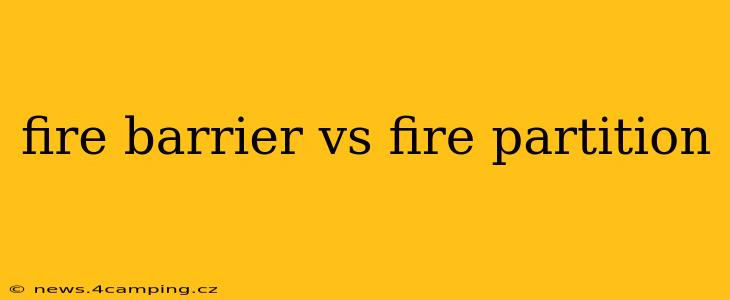Choosing the right fire-resistant construction is crucial for building safety. Two common terms often cause confusion: fire barriers and fire partitions. While both aim to limit the spread of fire, they differ significantly in their design, purpose, and application. This comprehensive guide clarifies the distinctions, helping you understand which is appropriate for your specific needs.
What is a Fire Barrier?
A fire barrier is a robust fire-resistant assembly designed to completely restrict the spread of fire, smoke, and hot gases between different sections of a building. Think of it as a highly effective firewall, creating separate fire compartments. This separation is crucial for allowing safe evacuation and preventing the rapid escalation of a fire throughout the entire structure. Fire barriers are typically constructed from materials like concrete, brick, or specialized fire-rated drywall systems, often requiring higher levels of fire resistance than partitions.
Key Features of Fire Barriers:
- Complete Separation: Fire barriers aim for total compartmentalization, preventing fire spread entirely.
- Higher Fire Resistance Rating: They usually boast higher fire resistance ratings (e.g., 2-hour or 4-hour rating) compared to partitions.
- Structural Integrity: They are often designed to maintain structural integrity even under intense fire conditions.
- Penetration Control: Careful attention is paid to the sealing of penetrations (pipes, conduits, etc.) to prevent fire from bypassing the barrier.
- Used in High-Risk Areas: Fire barriers are commonly used to separate high-risk areas like stairwells, exit routes, and potentially hazardous occupancies.
What is a Fire Partition?
A fire partition, on the other hand, provides a degree of fire resistance, but its primary function is often less about complete separation and more about slowing fire spread and containing it within a specific area, buying valuable time for evacuation and firefighting efforts. They are usually constructed from lighter materials and offer a lower fire resistance rating than fire barriers.
Key Features of Fire Partitions:
- Limited Spread Restriction: While they impede fire spread, they don't always guarantee complete separation.
- Lower Fire Resistance Rating: Typically have lower fire resistance ratings (e.g., 1-hour rating).
- Less Robust Construction: Generally constructed from lighter materials and may not maintain structural integrity under the same intense fire conditions as a barrier.
- Penetration Management: While penetrations should be carefully considered, the requirements are typically less stringent than with barriers.
- Used for Internal Dividers: Commonly used as internal dividers within a larger fire compartment to help control and limit fire growth.
What are the Differences Between a Fire Barrier and a Fire Partition?
The table below summarizes the key distinctions between fire barriers and fire partitions:
| Feature | Fire Barrier | Fire Partition |
|---|---|---|
| Primary Function | Complete fire separation | Slow fire spread, limited containment |
| Fire Resistance Rating | Higher (2-hour, 4-hour, or higher) | Lower (typically 1-hour) |
| Construction | More robust, often using heavier materials | Lighter construction materials |
| Structural Integrity | Designed to maintain integrity under fire | May not maintain integrity under intense fire |
| Penetration Control | Stringent requirements | Less stringent requirements |
| Typical Application | Separating distinct fire compartments, stairwells, exit routes | Internal subdivision within a fire compartment |
How to Choose Between a Fire Barrier and a Fire Partition?
The choice between a fire barrier and a fire partition depends entirely on the specific building codes, the intended use of the space, and the level of fire protection required. Consult with a qualified fire protection engineer or building inspector to determine the appropriate type of fire-resistant assembly for your project. Ignoring these requirements can have significant consequences for building safety and insurance compliance.
What are the building codes and regulations for fire barriers and partitions?
Building codes and regulations regarding fire barriers and partitions vary significantly depending on location and jurisdiction. These regulations specify the required fire resistance ratings, construction materials, and installation methods for both barriers and partitions. Consult your local building authority for the most up-to-date and accurate information regarding these codes. They will be able to provide detailed specifications and guidance to ensure compliance.
What materials are typically used for fire barriers and partitions?
Common materials for fire barriers include concrete, reinforced masonry, and specialized fire-rated drywall assemblies. Fire partitions frequently utilize fire-rated gypsum board, and sometimes other materials depending on the specific fire resistance rating required. Again, local building codes will dictate acceptable materials in each case.
This comprehensive guide provides a clear understanding of the distinctions between fire barriers and partitions. Remember, prioritizing building safety and consulting relevant professionals is paramount when making such crucial decisions.
